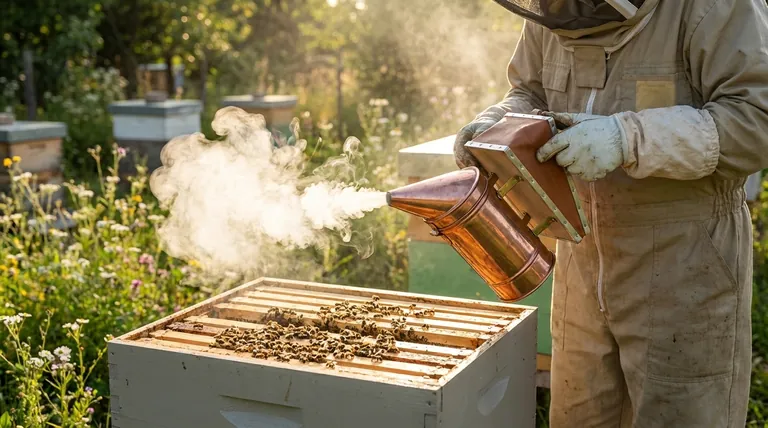The primary purpose of using smoke in beekeeping is to calm the honey bee colony during hive inspections. It disrupts the bees' natural defensive response, making hive management safer for the beekeeper and less stressful for the bees.
The core function of smoke is not to sedate the bees, but to interrupt their primary lines of communication. By masking alarm signals and triggering a natural survival instinct, smoke makes a colony docile and far less likely to sting.

How Smoke Influences Bee Behavior
Understanding why smoke is effective requires looking at two key bee behaviors it triggers. It is a manipulation of their natural instincts for communication and survival.
Masking the Alarm Pheromone
When a bee stings or feels threatened, it releases an alarm pheromone. This chemical signal instantly alerts other guard bees to the location of the threat, inciting a coordinated defensive attack.
Smoke effectively scrambles this signal. The particles in the smoke bind with the receptors the bees use to detect the pheromone, essentially making it impossible for them to smell the "call to arms."
Triggering a Feeding Response
On a more primal level, smoke signals a potential forest fire. The colony's instinctual reaction to this threat is not to attack, but to prepare to abandon the hive.
To do this, the bees will immediately begin consuming large amounts of honey. This ensures they have the energy reserves needed to fly a long distance and build a new home.
A bee with a full stomach of honey is physically less able to curl its abdomen to sting. This engorgement, combined with the masked alarm signals, results in a remarkably calm and manageable colony.
The Practical Benefits of Proper Smoking
When used correctly, smoke is an invaluable tool that benefits both the beekeeper and the bees. It transforms a potentially volatile interaction into a controlled procedure.
Increased Beekeeper Safety
The most immediate benefit is a dramatic reduction in stinging incidents. By preventing a mass defensive response, the beekeeper can work calmly and confidently without fear of being swarmed.
Reduced Stress and Casualties for Bees
A calm beekeeper is less likely to make sudden movements or accidentally crush bees. Furthermore, since honey bees die after they sting a mammal, preventing stings directly saves the lives of the colony's defenders.
More Efficient Hive Inspections
With the bees in a docile state, the beekeeper can perform necessary tasks—like checking for disease, assessing honey stores, or finding the queen—thoroughly and efficiently without causing lasting disruption or harm to the colony.
Understanding the Trade-offs and Best Practices
While highly effective, the use of smoke is a technique that must be performed correctly. Improper use can be counterproductive or even harmful.
The Importance of "Cool" Smoke
Quality smoke is cool and white. The goal is never to harm the bees with heat. You should always be able to puff the smoke onto the back of your hand without feeling any significant warmth. Hot smoke can easily burn and damage a bee's delicate wings.
The Risk of Over-smoking
A few gentle puffs at the hive entrance and under the lid are usually sufficient. Using too much smoke can drive the bees out of the hive, overly agitate them, or contaminate the taste of the honey.
Alternatives to Smoke
Some beekeepers prefer to work without smoke, opting instead for a light mist of sugar water or simply working with extreme care and gentleness. This approach is often reserved for very calm colonies or highly experienced beekeepers.
Making the Right Choice for Your Goal
Your approach to using smoke should align with your beekeeping philosophy and the temperament of your specific colony.
- If your primary focus is safety and efficiency: Learning to use a smoker correctly to produce cool, white smoke is the most reliable method for managing almost any colony.
- If your primary focus is minimal intervention: You might experiment with smoke-free techniques, but be prepared to use a smoker as a backup if the bees become defensive.
Ultimately, using smoke is a proven technique that enables beekeepers to care for their colonies effectively and safely by working with the bees' natural instincts.
Summary Table:
| Aspect | Purpose of Smoke |
|---|---|
| Primary Function | Calms the colony by disrupting defensive communication. |
| Key Mechanism | Masks alarm pheromones and triggers a honey-feeding instinct. |
| Main Benefit | Safer, less stressful hive inspections for beekeeper and bees. |
| Best Practice | Use cool, white smoke; avoid over-smoking to prevent agitation. |
Ready to work with your bees more safely and efficiently?
For commercial apiaries and equipment distributors, having reliable, high-quality beekeeping tools is essential for productive hive management. HONESTBEE supplies the durable smokers and protective equipment you need to conduct inspections confidently.
Let us help you equip your operation for success. Contact HONESTBEE today to discuss your wholesale supply needs.
Visual Guide

Related Products
- Premium Traditional Copper Bee Smoker with Bellows
- Stainless Steel Honey Bee Smoker Hive and Honeycomb Smoker for Beekeeping
- European Stainless Steel Bee Smoker for Honey Bee Hive
- Economy Galvanized Beekeeping Honey Bee Smoker for Wholesale
- Stainless Steel Electric Beehive Smoker for Beekeeping and Bee Keeper Use
People Also Ask
- What happens to bees when they sense smoke? Unlock the Secret to Calm Hive Inspections
- How did early beekeepers use bee smokers? Master Ancient Bee Calming Techniques
- What is a Smoker and how is it used in beekeeping? The Essential Tool for Calm, Safe Hive Inspections
- How does water mist work as an alternative to smoke in beehives? A Guide to Safe & Effective Use
- What are the benefits of using smoke properly in beekeeping? Achieve Calm, Safe Hive Inspections



















